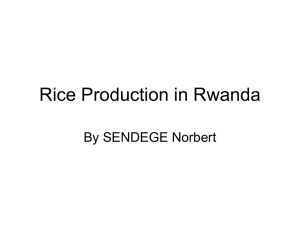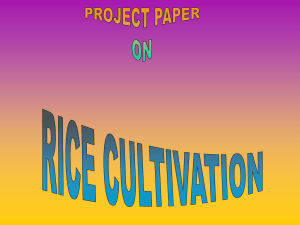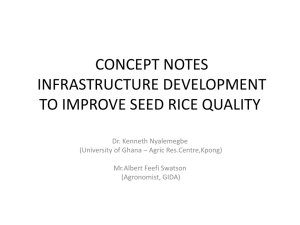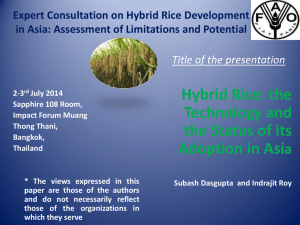presentation
advertisement
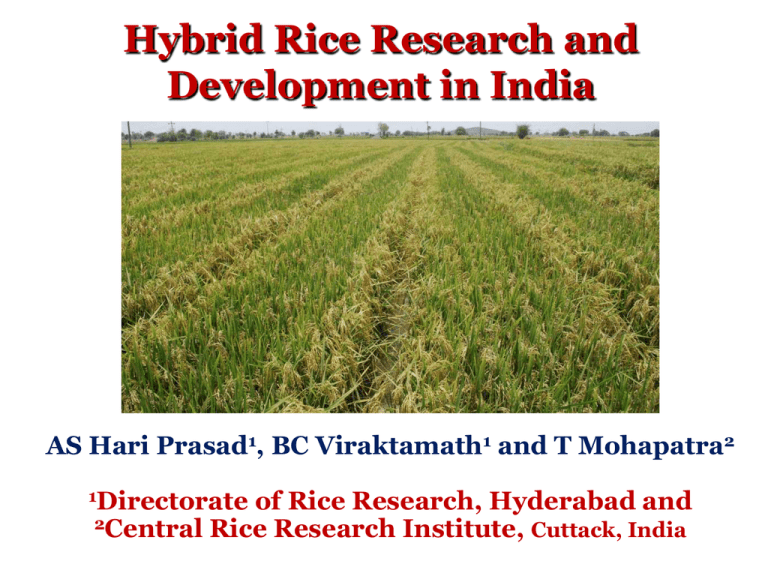
Hybrid Rice Research and Development in India AS Hari Prasad1, BC Viraktamath1 and T Mohapatra2 1Directorate of Rice Research, Hyderabad and 2Central Rice Research Institute, Cuttack, India Rice in India A staple food crop that holds the key for food security (43%) Occupies 44 M. ha (22% of cropped area) Annual Production > 100 M t A source of livelihood for millions Earns foreign exchange of > 6000 million US $) For India – Rice is life Rice – Our Heritage….. Population, production of food grains and rice Trends and Projections 1600 Population 1400 Food grain In Millions 1200 1200 Rice 1012.4 800 646.3 548.2 439.2 93.3 (2002) Rice 361.1 400 65.46 85.00 211.3 (2002) Food grains 111.53 146.55 201.6 90 0 1951-60 1961-70 1971-80 1981-90 1999-00 253 305 100 140 2009-10 2024-25 Irrigated Uplands Hills Area: 56.3 % Production: 63.5% Productivity: 3.0 t/ha Area: 16 % Production: 5.8% Productivity: 1.1 t/ha Area: < 1 % Production: < 1 % Productivity: 1.2 t/ha Rice is grown everywhere Below sea level (in Kuttanad) Rainfed Lowland Deep water Area: 23.7 % Production: 26.7% Productivity: 2.0 t/ha Area: 3.5 % Production: 4 % Productivity: 1.4 t/ha Hybrid Rice Research in India A systematic goal oriented project on hybrid rice was initiated by ICAR in December, 1989 This programme had financial support from ICAR, FAO, UNDP, Barwale Foundation and technical backstopping from IRRI, Philippines Private sector has also been playing key role in hybrid rice research and development This Programme was coordinated by the Directorate of Rice Research, Hyderabad National Hybrid Rice Research Network Delhi, Pantnagar, Faizabad, Karnal, Kapurthala DRR, Hyderabad Karjat SRC & CC Mandya, Maruteru, Coimbatore Cuttack, Chinsurah Major activities under Hybrid Rice Network Development and evaluation of hybrids Development and Improvement of parental lines Optimizing packages for hybrid rice cultivation and seed production Use of molecular tools for improving efficiency Technology dissemination Public-Private partnerships Coordinating the research activities Ongoing hybrid rice research activities Genetic improvement of maintainers and development of CMS lines Exploitation of inter sub-specific heterosis in rice Development and Evaluation of three line hybrids Breeding of parental lines and Hybrids suited to Aerobic and salinity/alkalinity Conditions Molecular breeding for Disease Resistance, Fertility Restoration and Wide Compatibility in Rice Evaluation of Hybrids Total hybrids evaluated : 3500 Hybrids Released : 70 Public Sector hybrids : 31 Private Sector hybrids : 39 Central Releases : 43 State Releases : 27 2013 2012 2011 2010 2009 2008 2007 2006 2005 2004 2003 2002 2001 2000 1999 1998 1997 1996 1995 Hybrid rice area in India (‘000 ha) Hybrid rice Seed Production Economic and efficient hybrid rice seed production is a prerequisite for successful adoption of hybrid rice Hybrid Rice Seed Production package Hybrid seed production activity generates additional employment of 65 person days/ha and most of them are women. Seed produced (Region wise) AP (Karimnagar and Warangal) (80) Others (4) Maharashtra (8) Hybrid rice seed produced (2012) Karnataka (8) Public-Private Partnership MOUs with Private Seed Companies Public Private partnerships Indian Hybrid Rice Consortium Hybrid rice cultivation (with 2.5 million hectares during 2013) has contributed: Additional 3-4 million tonnes to the total rice production in the country Generated additional employment of 60-80 days per hectare benefitting the rural communities. Constraints in Hybrid Rice Development Marginal heterosis of the available hybrids Narrow genetic base of the female parental lines Diversified consumer preferences for grain quality Very few hybrids in late duration and limited choice of hybrids for unfavourable ecologies Susceptibility of parental lines to major pests & diseases Higher seed cost Lower market price offered by the millers/traders Very low number of breeders (<20) involved in public sector Lack of strong institutional mechanism for production and supply of quality seed of public bred hybrids Lack of funding support for public sector research No uniform subsidy component on hybrid seed cost Restrictions on providing subsidy only to the Govt. notified hybrids Lack of focused extension strategy New generation hybrids devoid of many of the drawbacks of the earlier released ones already available and many in the pipeline Public policy in favour of increased private sector participation in research and development of new plant varieties/hybrids. Large and vibrant seed industry with proven capability to produce and supply quality seed Increasingly receptive farming community for adoption of hybrid technology. Seed certification continue to remain voluntary Subsidy on seed cost for notified hybrids Availability in abundance of qualified scientific and technical manpower for meeting the expanding seed industry need. Breeder strength in multinational companies is at desired level unlike in both public and Indian private sector companies Priority to hybrid rice research in the 12th Plan Key strategies and policy options to promote hybrid rice development in India Development of parental lines that can produce highly heterotic rice hybrids Development of heterotic gene pools (a concept well exploited in corn needs to be explored in hybrid rice development) Diversification of CMS sources Identification of alternate sources suitable for hybrid seed production Human resource development through exposure visits and training programmes Refining the seed production technology to enhance the seed yields, so that cost of hybrid rice seed can be reduced. Involvement of seed agencies in the public sector, NGOs, and farmers cooperatives along with private seed sector Strengthening the existing institutional mechanism for the production and supply of breeder, foundation, and certified seed Extension agencies to play greater role in creating much needed awareness among the farmers about the advantages of cultivating hybrid rice through various innovative strategies. Identification and popularization of promising hybrids for different states from the available released and notified hybrids Providing adequate funding support and human resources to the hybrid rice research and development in the country. Promoting through special schemes like ‘Bringing green revolution to Eastern India’ and ‘National Food Security Mission’ Providing a strong interface between the public sector and private seed sector for popularization of the technology. Encouraging the contract farming models involving hybrid rice cultivation in different parts of the country. Procurement of hybrid rice produce by FCI and other agencies for PDS




